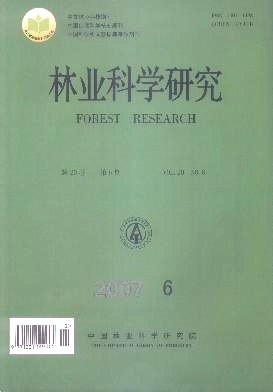Studies on the Composition and D iversity of the CanopyArthropod Commun ity of Moso Bamboo Forest
-
1.
Key Laboratory of Entomology and Pest Engineering of Chongqing, College of Plant Protection, Southwest University, Chongqing 400716, China
-
2.
General Station of Forest Plant Quarantine and Pest Control of Sichuan Province, Chengdu 610081, Sichuan, China
-
Received Date:
2006-10-16
-
Abstract
The survey of canopy arthropod community was conducted by netting from Ap ril to October in 1999 inChangning Bamboo Area, Yibing, Sichuan. The results indicated that there were 113 species ( group s) of canopy insects, which belonged to 13 orders and 54 families method. All sp iders were considered as one group because ofsimilar ecological functions. Homp tera and sp iders constituted the dominant group s in arthropod communities in thefour investigation areas. The relative abundance ranged from 30% to 51% for Homp tera and from19% to 43% forsp iders, respectively. Dominant concentration index of Simp son was in the order ofAreaⅡ >AreaⅢ >AreaⅣ >AreaⅠ. Em poasca sp. (Homp tera: Cicadellidae) was the a dominant species in four Areas. At p resent, it had already become one of the most important bamboo pests in China. The indices of dominant concentration and diversitywere used to analyze and compare the seasonal dynamics of arthropod community. The dynamics of dominant concentration started highly, then decreased to a low level, but finally increased to a relatively high level. The changetendencies of the dynamics of diversity (H′) were from low to high, then to low, and to high again, and to low finally. This trend was closely related to bionomics of arthropod and seasonal change, but there was difference in the four areas. The dynamics of the diversity in Area II was an excep tion as a result of the obvious dominance ofEm poasca sp. inMay. Its change tendencywas from high to low, then to high, and to low again, and to high again,and to low finally. The seasonal pattern of bamboo canopy arthropod communitywithin investigation period could bedivided into five stages by the op timal sorting. The five stageswere before earlyAp ril, from mid Ap ril to early June,from mid June to early Sep tember, from mid Sep tember to mid October, and after mid October, respectively. Thesecond stage forming the first peak was the most important and op timum time to monitor dynamics and control pestsbecause most pests appeared at this stage. At the third stage, the pests declined because of high temperature andoccasional strong wind. At the forth stage, temperature declined to a relatively suitable range. The second peak ofsome insect pests appeared and sp ider population also increased. Biological control should be emphasized at thisstage. The arthropod over-wintered between late October and next earlyAp ril. Forestmanagement should be emphasized to control the over-wintering pest populations.
-

-
References
|
[1]
|
赵志模,郭依泉. 群落生态学原理与方法[M]. 重庆:科学技术文献出版社重庆分社, 1990: 85~153
|
|
[2]
|
高宝嘉,申曙光,王正文,等. 园林昆虫群落时间结构及动态研究[J]. 生态学报, 1998, 18 (2) : 193~197
|
|
[3]
|
高宝嘉,张执中,李镇宇. 封山育林对昆虫群落结构及多样性、稳定性影响的研究[J]. 生态学报, 1992, 12 (1) : 1~7
|
|
[4]
|
戈峰,丁岩钦. 棉田生态系统中害虫、天敌群落结构与功能关系的研究[J]. 生态学报, 1996, 16 (5) : 535~540
|
|
[5]
|
Bach C E. Effects of p lant density and diversity on the populationdynamics of specialist herbivore, the striped cucumber beetle Aca2lymm ia vittata ( Fab. ) [J]. Ecology, 1980, 61: 1 515~1 530 |
|
[6]
|
戈峰,丁岩钦. 多样化的棉田生态系统挫系保益功能特征研究[J]. 应用生态学报, 1997, 8 (7) : 295~298
|
|
[7]
|
Le Kang. Dynamics of grasshopper communities under different graz2ing intensities in InnerMonqolia Steppes [J]. Entomologia Sinica,1995, 2 (3) : 265~281 |
|
[8]
|
郭依泉,朱文炳,赵志模. 桔园昆虫群落空间结构研究[J]. 西南农业大学学报, 1988, 34 (2) : 140~144
|
|
[9]
|
郝树广,张孝羲,程遐年. 稻田节肢动物群落营养层及优势功能集团的组成与多样性动态[J]. 昆虫学报, 1998, 41 (3) : 343~352
|
|
[10]
|
金翠霞,吴亚,王冬兰. 稻田节肢动物群落的多样性[J]. 昆虫学报, 1990, 33 (3) : 287~295
|
|
[11]
|
谭济才. 不同类型茶园昆虫蜘蛛群落结构分析[J]. 生态学报,1998, 18 (3) : 289~299
|
|
[12]
|
尤民生,吴中孚. 福州郊区稻田节肢动物群落的结构和动态[J]. 福建农学院学报, 1992, 1 (1) : 56~62
|
|
[13]
|
张永强. 农田蜘蛛群落结构及其多样性研究[J]. 生态学报,1989, 9 (2) : 157~162
|
|
[14]
|
赵志模,朱文炳,郭依泉. 桔园昆虫群落演替的初步研究[J].西南农学院学报, 1985, 32 (3) : 135~143
|
|
[15]
|
李世东,许俊德. 中国竹业发展历程与21世纪发展战略[J]. 竹子研究汇刊, 1998, 17 (1) : 1~5
|
|
[16]
|
马林珍. 我国竹类资源及其开发利用[J]. 自然资源, 1994(9) : 68~72
|
|
[17]
|
周芳纯. 竹林培育和利用[J]. 竹类研究, 1998 ( 58、59) : 1~297
|
|
[18]
|
农业部. 中国农业年鉴. 北京: 中国农业出版社[M] , 1998: 1~200
|
|
[19]
|
张飞萍,陈清林,施友文,等. 毛竹林林下植被、竹叶化学成分与节肢动物群落的关系[J]. 林业科学, 2006, 42 (8) : 51~57
|
|
[20]
|
张飞萍,陈清林,吴庆锥,等. 毛竹林节肢动物群落的组成与结构[J]. 生态学报, 2005, 25 (9) : 2 272~2 283
|
-
-
Proportional views

-





 DownLoad:
DownLoad: